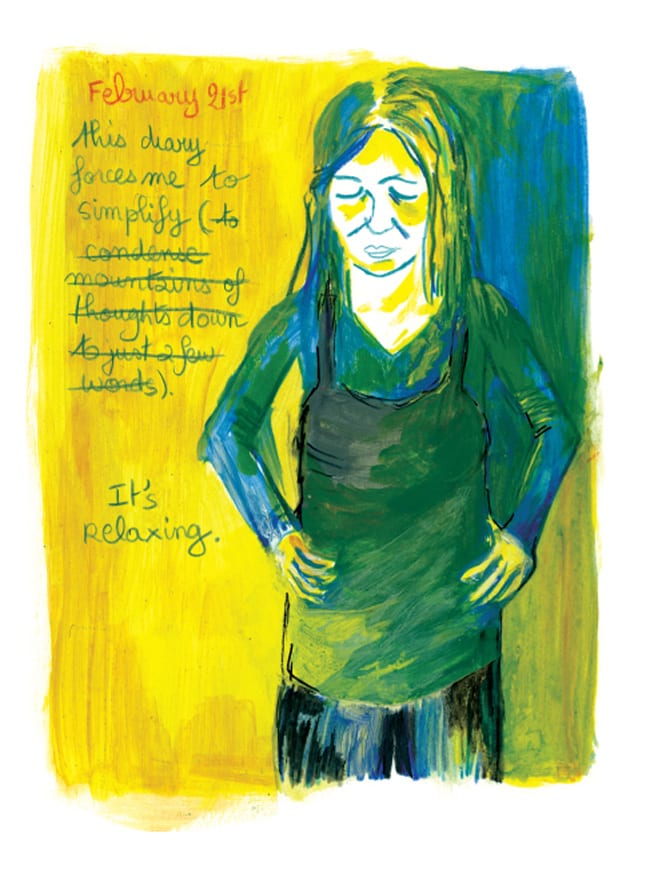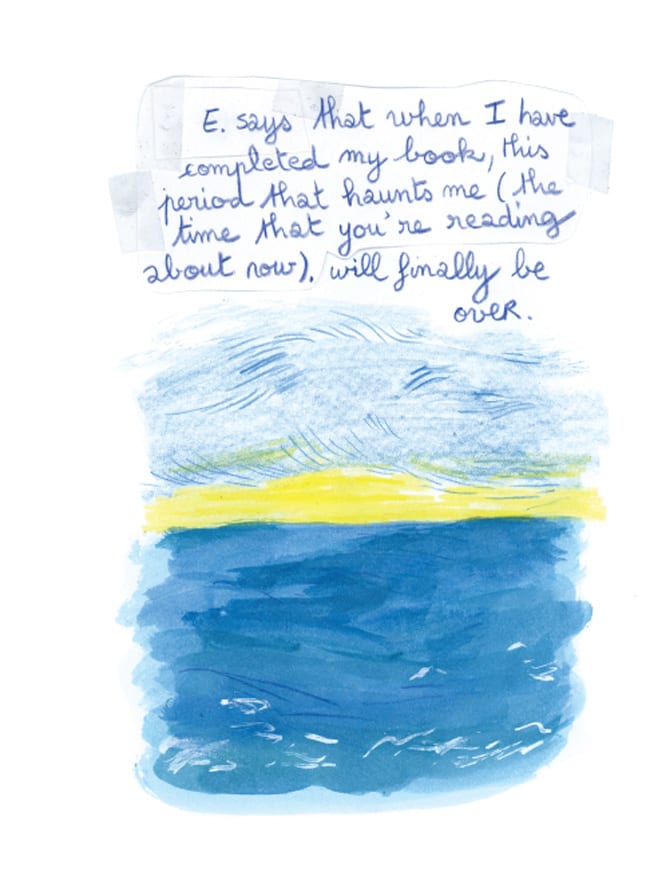On the first page of her Journal, French-Canadian artist Julie Delporte writes, “Here we go. We’ve decided not to live together any more. I’m experimenting with colours as we’re experimenting with new lives… improvising a lot.” That encapsulates perfectly this striking book from Koyama Press: colorful, visual ad-libbing.
Over the span of roughly a year (Feb 2011 to Oct 2012), Delporte chronicled the emotionally chaotic, physically taxing aftermath of a breakup, examining and illustrating her emotions, flights of fancy, memories, and ups and downs in quick but minute detail. With her poetic visual acumen, Delporte takes you places you may have been before, but makes them all a lot prettier. Unlike the effectively stark black and white panels of fellow Koyama Press author Jane Mai, who delineates her bouts with anxiety and depression in Sunday in the Park with Boys, Delporte’s pages are gorgeously rendered in soft, radiantly colored pencils that belie the quiet grief at their core.
The loose plot follows Delporte’s progress immediately following the initial split. Right from the start we assume the breakup - though painful - is going to be amicable; she describes apartment-hunting with her ex (though she lets him have the best apartment, opting instead for a temporary three-month stay with her “Belgian friends”). Her ex moves out, and Delporte eventually makes her way from Montreal out to Vermont’s Center for Cartoon Studies (CCS) for a semester-long fellowship. All the while she continues improvising: drawing and writing her journal entries, sorting out her emotions while trying to move forward. She sometimes succeeds, sometimes doesn't: “Every time I reach the surface, it’s as if something pushes me back down to the bottom.”
This is familiar material for autobiographical comics. What distinguishes Journal from others is not content, but rather, form. In her exit interview with James Sturm at CCS, Delporte stated that she doesn’t do preliminary sketches, drawing instead directly onto the page. When she’s dissatisfied with the results, she cuts and pastes another drawing over the first. As with the still-visible erased pencil marks in Amanda Vähämäki’s comics, Delporte leaves the traces of her corrections clearly visible on the final images. She tells Sturm, “I try to leave all the tracks of the collage, the tape…” This improvisation lends her drawings a charmingly spontaneous, organic quality, creating an informal intimacy between artist and reader, making us privy to her artistic process.
Delporte kept this journal as therapy; her drawing is the primary method of dealing with and processing her loss and heartache, serving as an escape valve as well. On one page she notes that drawing also helped overcome language barriers during her semester at CCS (her native language is French): “Drawing manages to reconnect me.” The universal language.
Going inside oneself is sometimes necessary, but it’s important to know when to reemerge and rejoin the rest of the world. In the closing pages of Journal Delporte notes, “I don’t write in my diary anymore. Some say: ‘To live happy, live hidden’ (…) As a teenager, I wanted to keep everything in my memory (…) now, I’m almost 30, and I’d like, on the contrary…… for everything behind me to be erased.” Delporte gives credence to the quote attributed to Leonardo Da Vinci: “Art is never finished, only abandoned.” Her journal—a work of improvised art—could have gone on indefinitely, but she chose to find an ending.










